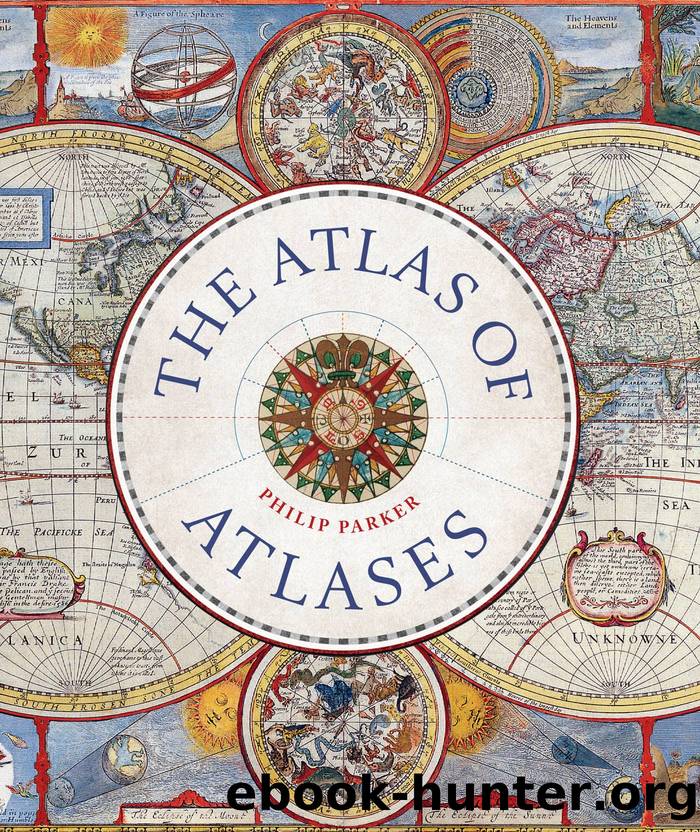The Atlas of Atlases by Philip Parker

Author:Philip Parker
Language: eng
Format: epub
Publisher: Ivy Press
Published: 2022-01-15T00:00:00+00:00
Italy, Klencke Atlas, presented 1660
Of more immediately practical use, the Dutch shipping industryâs need for navigational charts meant that the market for Waghenaers (or wagoneers) and rutters (here) continued to be healthy. Willem Janszoon Blaeuâs own Het Licht der Zeevaerdt underwent no fewer than six editions between 1608 and 1629, facing off rivalry from Claeszoonâs new edition of Waghenaerâs original pilot guide (published as Nieuwe thresoor der zee-vaert in 1609), but suffering the occupational hazard of plagiarism, this time by his perennial rival Janssonius. As a result, in 1623 Blaeu published yet another pilot guide, the Zeespiegel (âSea Mirrorâ), which his publishing house guided through 15 editions between then and 1653.
Further versions followed, each seemingly with a more outlandish name than its competitors, all intended, no doubt, to gain attention in a crowded market. Jacob Colom (1600â73) produced the De Vyerighe Colom (âThe Sea Columnâ) in 1632, its title a playful reference to his own name, which earned its own counter-reference when Pieter Goos published the Zeespiegel in 1650, which in its English edition was entitled âThe Lightning Columnâ (and included an inscription charmingly giving Goosâs address as âon the water at the Sign of the Golden Sea Mirrorâ). Colom rather provocatively challenged Blaeu in De Vyerighe Colom, when he explained that his purpose was to ensure âThe defects and errors of the previous Light or Mirror of the Sea are exposed and correctedâ. He nevertheless managed to survive in the cut-throat world of Amsterdam map publishing, bringing out over twenty editions of the Fiery Column (including in English and French) and also issuing two alternative versions, one in portrait form, called Oprecht Fyrie Columne (âThe Upright Fyrie Columneâ), the other in a larger folio format (as De Groote Lichte ofte Vyerighe Colom) in 1651.
By the end of the seventeenth century, the baton of leading cartographer had been taken up in the Netherlands by Johannes van Keulen (1654â1715). His De groote nieuwe vermeerderde zee-atlas ofte water-werelt (âGreat New Enlarged Sea Atlas of the Water Worldâ), published in 1680, was supplemented the following year with a substantial five-volume pilot guide entitled De nieuwe Groote lichtende zee-fakkel (âThe New Great Shining Sea Beaconâ), completed in 1681, which provided the first truly global pilot guide for the Dutch market.
Van Keulenâs sea atlas was part of a new genre, a somewhat different stream of atlases to the grand Mercator-style productions of the Blaeus. Unlike the wagoneers and rutters, these covered all the worldâs coastlines (rather than merely local routes and ports described by the pilot guides) and could be used on board ship for more general planning, as well as on land by merchants or as a prestige item. Somewhat in the spirit of the old portolans, the first maritime atlas appeared in 1650, published by Johannes Janssonius, appropriately enough under the name the Waterwereld (âWater worldâ). It led to a cascade of competitors, including Arnold Colomâs (1624â68) Zee-Atlas ofte waterwereldt (âSea Atlas of the Water Worldâ) in 1658 and his father Jacob Colomâs Atlas of werelts-water-deel (âAtlas of the Watery Part of the Worldâ) in 1663.
Download
This site does not store any files on its server. We only index and link to content provided by other sites. Please contact the content providers to delete copyright contents if any and email us, we'll remove relevant links or contents immediately.
Man-made Catastrophes and Risk Information Concealment by Dmitry Chernov & Didier Sornette(5650)
The Revenge of Geography: What the Map Tells Us About Coming Conflicts and the Battle Against Fate by Kaplan Robert D(3961)
Zero Waste Home by Bea Johnson(3655)
In a Sunburned Country by Bill Bryson(3368)
COSMOS by Carl Sagan(3348)
Good by S. Walden(3347)
The Fate of Rome: Climate, Disease, and the End of an Empire (The Princeton History of the Ancient World) by Kyle Harper(2873)
Camino Island by John Grisham(2719)
A Wilder Time by William E. Glassley(2690)
Organic Mushroom Farming and Mycoremediation by Tradd Cotter(2567)
The Ogre by Doug Scott(2501)
Human Dynamics Research in Smart and Connected Communities by Shih-Lung Shaw & Daniel Sui(2431)
Energy Myths and Realities by Vaclav Smil(2380)
The Traveler's Gift by Andy Andrews(2299)
9781803241661-PYTHON FOR ARCGIS PRO by Unknown(2269)
Inside the Middle East by Avi Melamed(2230)
Birds of New Guinea by Pratt Thane K.; Beehler Bruce M.; Anderton John C(2175)
A History of Warfare by John Keegan(2105)
Ultimate Navigation Manual by Lyle Brotherton(2048)
